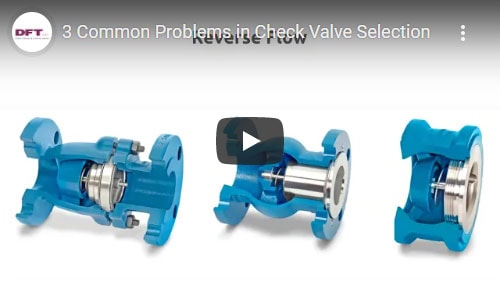3 Common Problems in Check Valve Selection
Did you know that, unlike other types of valves, check valves continue to work if a plant loses electricity, air, manpower, or all of the above? They come in a wide variety of sizes, materials, and end connections, and can be used in countless applications.
So why is it that they’re often improperly sized or selected? It’s because check valves are only as good as their application. Oftentimes the problems with a check valve are not related to the valve itself, but application and other factors. So when you’re problem solving or replacing a check valve, keep these three common problems in mind:
Water Hammer
Water hammer is one of the most common check valve problems. Water hammer is a pressure surge that’s caused when a liquid or gas is forced to stop or change direction suddenly, and often occurs when a valve is suddenly closed at the end of a pipeline system. This can result in both noise and vibration, which can in turn lead to damage and additional maintenance or repair costs.
Water hammer can be prevented, however, by using a faster-closing check valve that stops the pressure surges and shock waves that can damage and rupture equipment. Our silent check valves in particular are known for their effectiveness in preventing and in many cases eliminating water hammer.
Reverse Flow
Reverse flow is another common check valve problem and can be extremely costly, especially when it occurs at the discharge of a pump, causing the pump to spin backwards.
A fast-closing and tight shut off valve is necessary to prevent this problem, and the right spring-assisted in-line check valve will do just that, eliminating reverse flow.
Oversizing
If there is a lot of valve chatter—opening and closing of the valve repeatedly—chances are it’s due to oversizing. What’s important to remember is that check valves should be sized for the application, and not for the line size. You want the disc to be stable against the internal stop in the open position or fully closed; this will result in no repeated fluttering, and therefore no premature failure.
Keep these common problems in mind, select the right check valve for your application and your check valves will last longer and work more effectively for your applications.
Have questions or want to know more information on Check Valves? Contact DFT today or download our full Check Valve catalog to see what options we offer.













6 Comments
samir salim
Really im happy to read ur article and have problem i have 3 tilting check valve 350 mm but when pump stop i heard very high noise and its close make vibration in all the line and pump and to know the pump discharge is 300 mm.
Please tell me whay can i do to overcome this problem?
DFT
The problem you are experiencing is water hammer, also called hydraulic shock. The pump you are describing is most likely discharging into a vertical pipe run. When the pump is running the water column is moving through the pipe system with no problems. When the pump shuts down the water column reverses direction due to gravity and is now flowing back to the pump. The tilting disc check valve will not react to the pump shutdown, but rather to the reversing of the flow by gravity. The tilting disc then slams against the seat in the valve causing a shock wave to be transmitted through the liquid in the pipe system. Left unresolved this repeated pressure shock will damage other components in your system like gauges and flow meters, leading to even more expensive, on-going repairs. The solution is to replace the tilting disc valve with an axial flow check valve like the DFT model Excalibur. This valve will have the same take out dimension as the tilting disc valve and will be a very easy solution to your water hammer problem. Please contact DFT for the name of your closest DFT distributor: https://industrial.dft-valves.com/contact-dft-dft-inc
Rohan Kedare
Dear sir,
In our case check valve is in steam line. We are experiencing chattering noise in normal operation. So is it due to Oversizing of valve.
Deb Manz
Hello Rohan,
Yes, the chattering noise usually indicates being oversized but it may also be due to turbulence. If you would like to discuss further, please contact us at dft@dft-valves.com.
Bart
Can I upload a video with the sound I hear?
DFT Valves
Hello Bart,
If you would like to talk with someone at DFT about a problem you are experiencing, please contact us at dft@dft-valves.com.
Thank you for your inquiry.